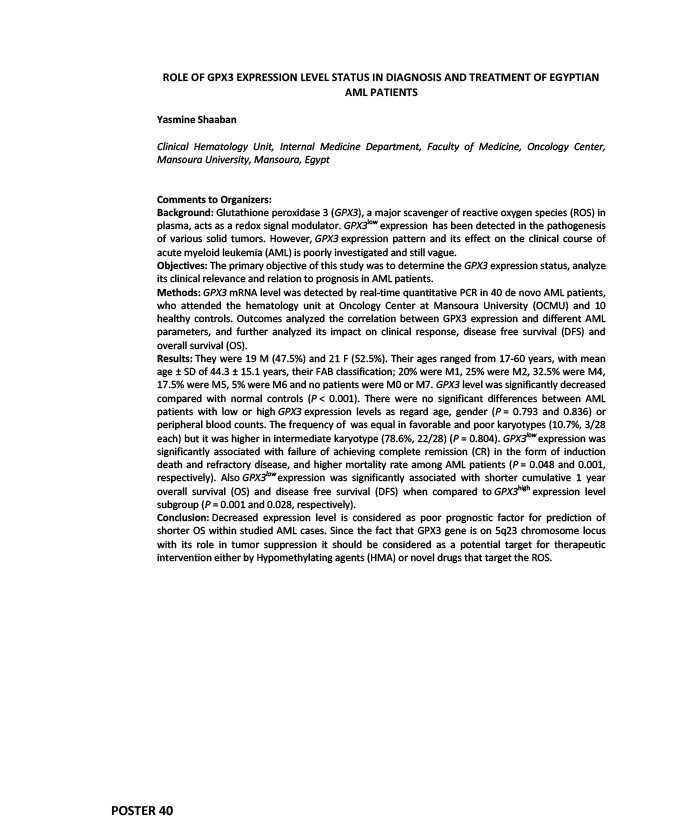
ROLE OF GPX3 EXPRESSION LEVEL STATUS IN DIAGNOSIS AND TREATMENT OF EGYPTIAN
POSTER 40
AML PATIENTS
Yasmine Shaaban
Clinical Hematology Unit, Internal Medicine Department, Faculty of Medicine, Oncology Center,
Mansoura University, Mansoura, Egypt
Comments to Organizers:
Background: Glutathione peroxidase 3 (GPX3), a major scavenger of reactive oxygen species (ROS) in
plasma, acts as a redox signal modulator. GPX3low expression has been detected in the pathogenesis
of various solid tumors. However, GPX3 expression pattern and its effect on the clinical course of
acute myeloid leukemia (AML) is poorly investigated and still vague.
Objectives: The primary objective of this study was to determine the GPX3 expression status, analyze
its clinical relevance and relation to prognosis in AML patients.
Methods: GPX3 mRNA level was detected by real-time quantitative PCR in 40 de novo AML patients,
who attended the hematology unit at Oncology Center at Mansoura University (OCMU) and 10
healthy controls. Outcomes analyzed the correlation between GPX3 expression and different AML
parameters, and further analyzed its impact on clinical response, disease free survival (DFS) and
overall survival (OS).
Results: They were 19 M (47.5%) and 21 F (52.5%). Their ages ranged from 17-60 years, with mean
age ± SD of 44.3 ± 15.1 years, their FAB classification; 20% were M1, 25% were M2, 32.5% were M4,
17.5% were M5, 5% were M6 and no patients were M0 or M7. GPX3 level was significantly decreased
compared with normal controls (P < 0.001). There were no significant differences between AML
patients with low or high GPX3 expression levels as regard age, gender (P = 0.793 and 0.836) or
peripheral blood counts. The frequency of was equal in favorable and poor karyotypes (10.7%, 3/28
each) but it was higher in intermediate karyotype (78.6%, 22/28) (P = 0.804). GPX3low expression was
significantly associated with failure of achieving complete remission (CR) in the form of induction
death and refractory disease, and higher mortality rate among AML patients (P = 0.048 and 0.001,
respectively). Also GPX3low expression was significantly associated with shorter cumulative 1 year
overall survival (OS) and disease free survival (DFS) when compared to GPX3high expression level
subgroup (P = 0.001 and 0.028, respectively).
Conclusion: Decreased expression level is considered as poor prognostic factor for prediction of
shorter OS within studied AML cases. Since the fact that GPX3 gene is on 5q23 chromosome locus
with its role in tumor suppression it should be considered as a potential target for therapeutic
intervention either by Hypomethylating agents (HMA) or novel drugs that target the ROS.